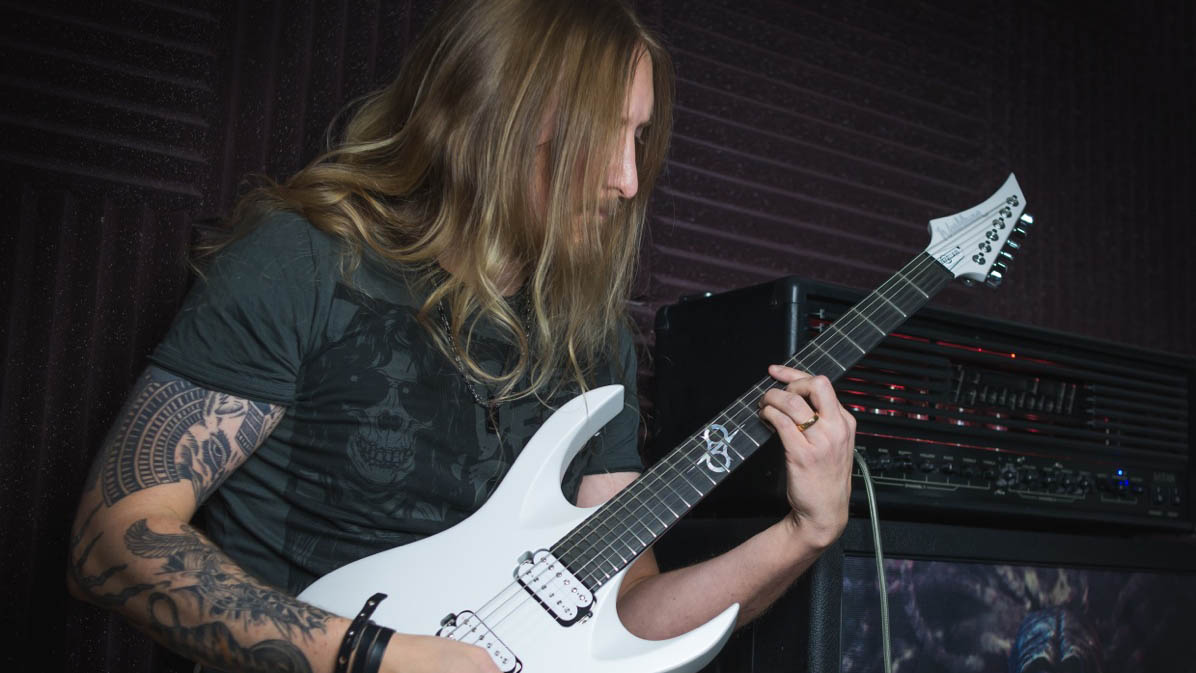Ola Englund's top 5 tips for guitarists
The Haunted and Feared man on songwriting, Dimebag and more

Introduction
It’s a frozen winter’s evening in Stockholm, Sweden, with endless rain falling from a dark sky. There’s one resident, however, who isn’t at home. Guitarist Ola Englund – who currently plays in The Haunted and his own project Feared – is 6,000 miles away in Rio De Janeiro on a clinic tour that's heading to UK shores. It’s amazing the places your guitar can take you…
“I'm having a day off here,” he smiles. “It's pretty unreal! Not everyone gets to do this… I'm super-happy.
“I’ve come to South America before, but this is my first time in Brazil. It doesn't differ too much, quite similar to Mediterranean culture, I would say! But I notice they are very passionate music fans.
“When you see them, it makes us in Europe look like we’ve forgotten what it's like to be a real fan. It's not the same in Europe any more; people are very used to seeing shows as bands are coming in and out all the time. Over here they don't get as much, so it's really awesome to see the passion, drive and enthusiasm they have.”
There’s a reason why Englund is out there while others are not. His striking fretwork demonstrating gear on YouTube has established his name within the guitar community – a widely trusted source of expertise in performance recording. He pretty much became the Mr Metal of online guitar.
More recently, he’s been working with Kemper Profiling Amplifiers, even engineering a good few of the tones that ship out from the German factory.
“It’s such a good piece of equipment and so much fun to dial around with because of the big buttons and wheels,” he nods.
“And it usually sounds awesome from the moment you plug in. Especially with my one of my signature Washburn Solar guitars, which are pretty straightforward six- or seven-string metal machines. I wanted my range to be simple and super-easy to play, which they are!”
I'm gonna shred a little bit, but there'll be more time on my story going from a bedroom player to where I am today
So, while he’s over, what can we expect from the workshops? How do you go about teaching people things that others haven’t?
“I'm not a virtuoso,” admits Englund. “I’m more like a rhythm player that does leads once in a while. A lot of people go to clinics because they want to see someone play fast.
“What can I offer? Of course I'm gonna shred a little bit, but there'll be more time on my story going from a bedroom player – which many people get stuck at – to where I am today. How I used social media to get to where I wanted to be, getting recognition and promoting myself to a point where I could join bands like Six Feet Under or The Haunted or making my own band Feared even bigger.”
And here, the guitarist gives us five tips to follow suit…
Ola Englund hosts a series of UK clinics from 7 to 9 December – head over to Sound Technology for ticket links.
Don't miss
John 5's top 5 tips for guitarists

1. Put down the guitar
“A lot of people say the guitar is part of them, but it’s not like that for me. The guitar is actually in the way of what I want to achieve! It’s easier to use my voice.
“I’m not Guthrie Govan; I’m not a musical genius. I look at the guitar as a recording tool for my music, and for writing it can be a lot better to use your voice to write what you hear in your head. You don’t have to be a singer!
“Writing this way is really good for finding your own ideas and melodies. You don’t have the buffer, which is the guitar in this case… If you try to sing riffs, you’ll start to come up with something really different and cool.
“If there’s no guitar, I record and sing into my phone. It sounds really stupid, but later I’ll pick up my guitar and transcribe what I sang. That’s my main approach to writing leads for a song; I think about the rhythms and other parts, then sing out different leads. I’ll listen to it, transcribe it and start adding more cool stuff.”

2. Take a birds-eye perspective
“When you’re finishing writing, you’ve got to be able to analyse your song to make it better and more digestible. When you hear it, do the parts make sense? Is it just a bunch of cool riffs taped together? Is it a song with a flow? It’s very important to kill your darlings, kill your riffs, in favour of the song.
“I listen to a lot of music every day, and I hear a lot of good riffs, but most of the time they’re stacked on top of each other. It’s just one after the other. It’s like hearing someone trying to fit everything cool into one song but it’s not really doing the song any favours. The dynamic flow isn’t there.
“You have to think about the full perspective of the song, and beyond that, the album. You want to keep the listener interested, so getting rid of anything that doesn’t work will make you a better songwriter.
“Things might not fit, and you can always save them for later. This is very unromantic, but I have a riff library on my computer, where I store all my unused riffs. If I’m stuck, I’ll just go through the library and get some inspirations from there.
“But relying on just cool riffs might not be enough. I’ve always loved Dream Theater’s Metropolis Pt. 2: Scenes From A Memory for its sense of flow; it could be one piece. You hear elements of all the songs in every song… it’s really impressive!”

3. What would Dimebag do?
“I’ve been writing riffs for so long that I know when I’m not coming up with something good. In that situation, I just keep on moving. It’s definitely something to be in the habit of, even if it feels awkward.
“Keep on going until you finding something good. This is something Dimebag Darrell said – once he was stuck in a rut, his dad told him, ‘If you write one riff a day, think how many you’ll have at the end of the year?’ That’s a lot of riffs!
“I’m one of Dimebag’s biggest fans, so it’s always good to think, 'What would he do?' It’s not just the leads; Dimebag was an exceptional rhythm player and writer. The power of his riffs [was that they] were so memorable and sound so modern to this day.
“Take something like Walk; that’s just two notes, but when I first heard it I thought, ‘Holy shit? What the hell is that?!’ That’s the beauty of songwriting: making something simple and memorable so it has a big impact on the listener. That’s what I look for.
“It was in the mid-90s when I first started playing guitar, and he is what got me interested in guitar sounds. I’d never heard anything like that before and was so blown away by how aggressive he sounded. That made me want to get into the production side and creating sounds rather than practicing all day to become more technical. So, thank you, Dimebag!”

4. Quality is important
“One of my first goals when I started my YouTube channel was for my videos to be at the top of search results when people were looking for gear demonstrations. I'd do these professional Mesa Boogie Dual Rectifier tests and ended up getting to the top.
“Now there's millions and millions of gear tests, it’s almost impossible. When I started doing these videos, I didn’t realise what impact it would have, just sat there showcasing an amplifier.
“Before, the quality was just awful, like people sat in their basements with a small cameraphone. I think I was pretty early with the high-quality audio and video – that’s why there was a big push in my views; it brought me out on top of everyone else. That’s kind of how I’ve been staying afloat, I would say!”

5. Don't just practise scales all the time
“If you have a practice routine, that’s good! That’s how you get better at different techniques, improve your sweeps and scales… that’s super-awesome. But one thing you can’t forget is to practise writing songs every day, and I think it’s something people overlook.
“So, make it part of your regime, because being a good songwriter is much more impressive than just being a technical player. Knowing how to make a simple lick or riff memorable, that’s the key.
“How to get better at writing songs is the same as playing fast: you practise. You need to do it every day and you’ll become better at filtering through your music. That’s how you develop your ear, through trial and error!”
Don't miss
John 5's top 5 tips for guitarists
Amit has been writing for titles like Total Guitar, MusicRadar and Guitar World for over a decade and counts Richie Kotzen, Guthrie Govan and Jeff Beck among his primary influences. He's interviewed everyone from Ozzy Osbourne and Lemmy to Slash and Jimmy Page, and once even traded solos with a member of Slayer on a track released internationally. As a session guitarist, he's played alongside members of Judas Priest and Uriah Heep in London ensemble Metalworks, as well as handling lead guitars for legends like Glen Matlock (Sex Pistols, The Faces) and Stu Hamm (Steve Vai, Joe Satriani, G3).
